DrawZero Examples
This page contains a gallery of examples demonstrating the capabilities of the DrawZero library.
Getting Started
These examples show the very basics of getting an image on the screen.
00_hello_world.py
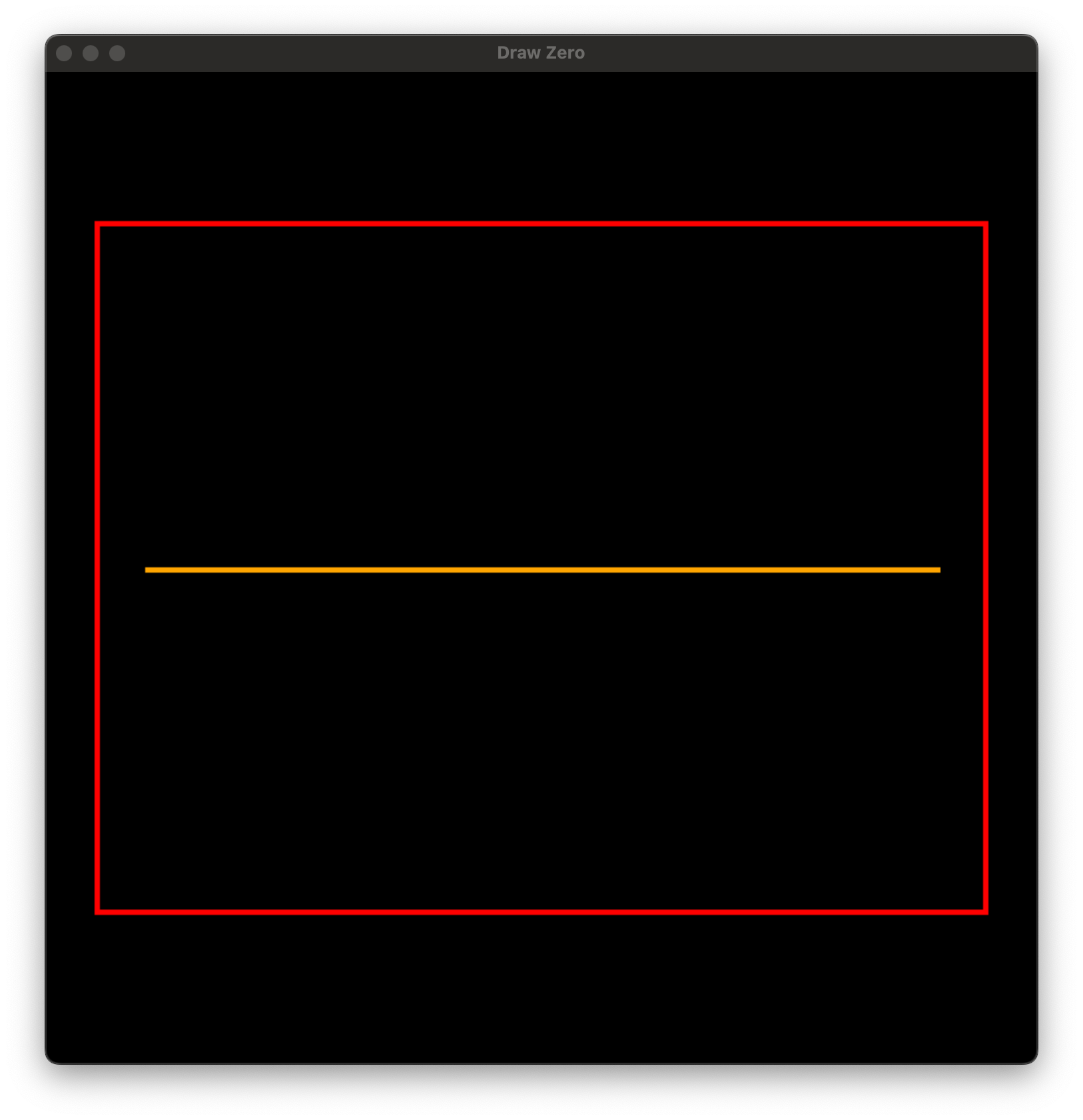
00_hello_world.py
# Just import everything
# Импортируем всё
from drawzero import *
# Red rectangle with upper left corner at (50, 150) and width = 900, height = 700
# Красный прямоугольник с левым верхнем углом в точке(50, 150), шириной 900 и высотой 700
rect('red', (50, 150), 900, 700)
# Straight orange line from (100, 500) to (900, 500)
# Оранжевая прямая линия из точки (100, 500) в точку (900, 500)
line('orange', (100, 500), (900, 500))
# Centered text
# Центрированный текст
text('green', 'Hello world!', (500, 250), fontsize=72)
text('blue', 'Привет, мир!', (500, 750), fontsize=72)
01_grid_and_coordinates.py
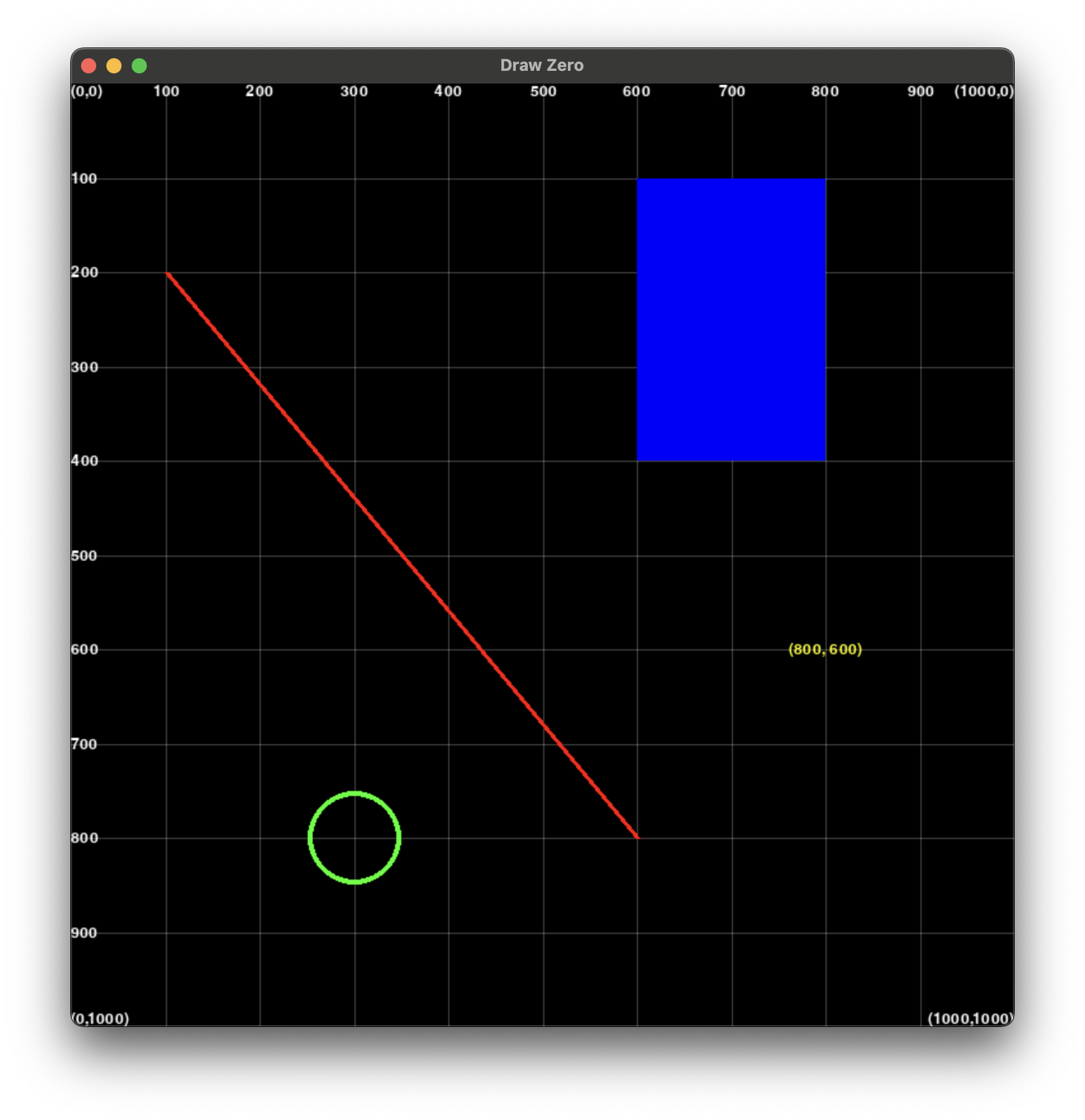
01_grid_and_coordinates.py
from drawzero import *
# Canvas is always 1000×1000
# Размер холста всегда 1000×1000
# Coordinate grid
# Координатная сетка для упрощения рисования
grid()
# (100, 200) -> (600, 800)
line('red', (100, 200), (600, 800))
# ┌─ at (600, 100), width=200, height=300
filled_rect('blue', (600, 100), 200, 300)
# Center at (300, 800), radius = 50
circle('green', (300, 800), 50)
# Center of text at (800, 600)
text('yellow', '(800, 600)', (800, 600))
Using Loops and Colors
Learn how to use loops to create more complex patterns and how to work with different colors.
02_loops_and_rgb_colors.py
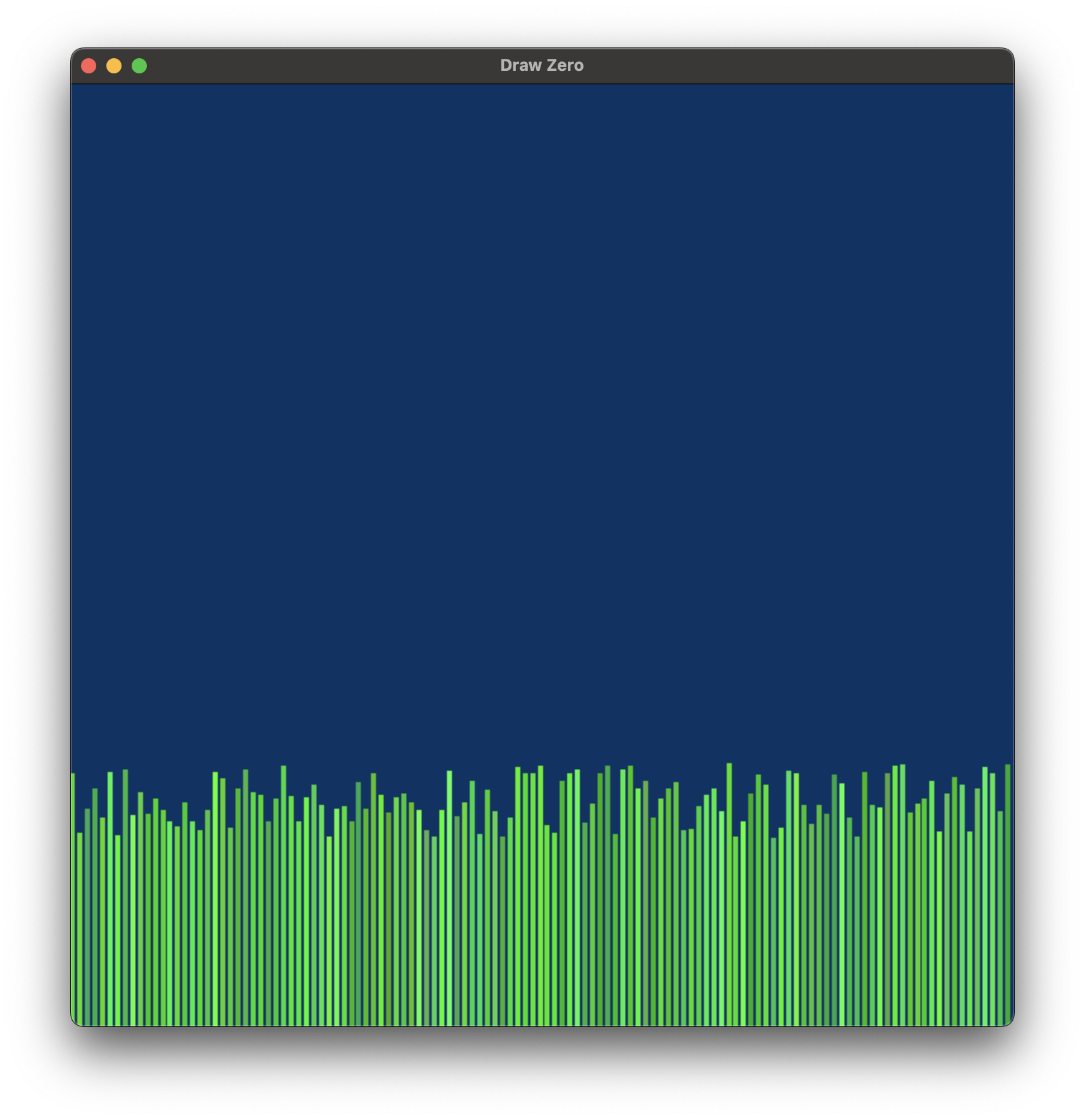
02_loops_and_rgb_colors.py
from drawzero import *
from random import randint, seed
# Fill with color #003366 (Dark midnight blue)
# Заливка цветом #003366 (Dark midnight blue)
fill('#003366')
# Draw a vertical line every 8 "pixels"
# Будем рисовать линию через каждые 8 пунктов
for x in range(0, 1000, 8):
# Color is defined by 3 components: red, greed and blue. Take them at random
# Каждый цвет состоит из трёх компонент: красной, зелёной и синей. Выбираем их случайно
red = randint(0, 90)
green = 255 - randint(0, 90)
blue = randint(0, 90)
random_green_color = (red, green, blue)
# Take line height at random too.
# Высота тоже случайная
height = 200 + randint(0, 80)
# 1000 — is the bottom of the canvas
# 1000 самый низ экрана
line(random_green_color, (x, 1000 - height), (x, 1000))
03_simple_objects.py
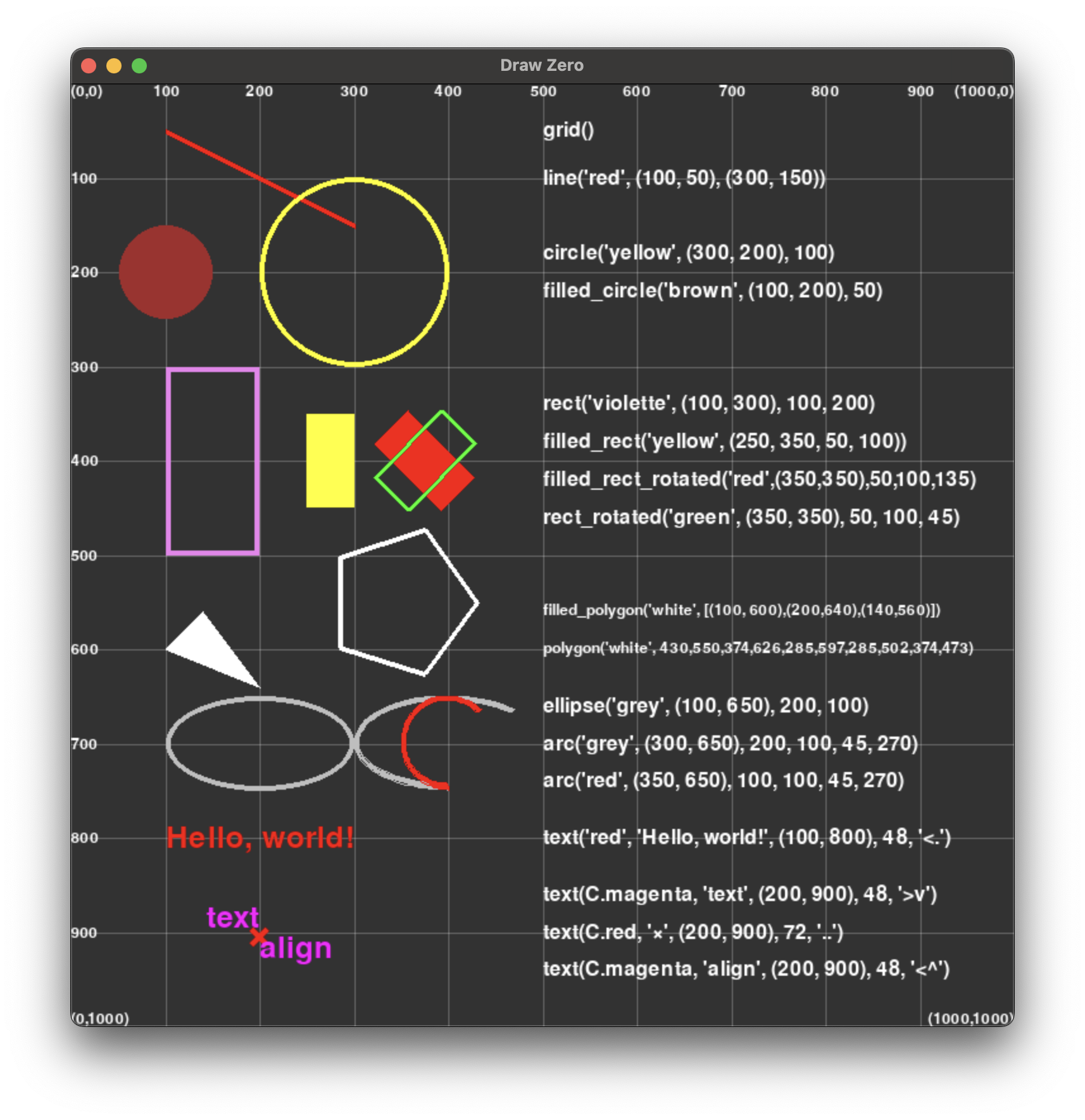
03_simple_objects.py
from drawzero import *
# All shapes
# Fill with color rgb=(50, 50, 50)
fill((50, 50, 50))
# Grid
grid()
text('white', "grid()", (500, 50), 32, '<.')
# Straight line
line('red', (100, 50), (300, 150))
text('white', "line('red', (100, 50), (300, 150))", (500, 100), 32, '<.')
# Circles
circle('yellow', (300, 200), 100)
filled_circle('brown', (100, 200), 50)
text('white', "circle('yellow', (300, 200), 100)", (500, 200 - 20), 32, '<.')
text('white', "filled_circle('brown', (100, 200), 50)", (500, 200 + 20), 32, '<.')
# Rectangles
rect('violet', (100, 300), 100, 200)
filled_rect('yellow', (250, 350, 50, 100)) # tuple[x,y,w,h] is also OK
filled_rect_rotated('red', (350, 350), 50, 100, 135)
rect_rotated('green', (350, 350), 50, 100, 45)
text('white', "rect('violette', (100, 300), 100, 200)", (500, 400 - 40 - 20), 32, '<.')
text('white', "filled_rect('yellow', (250, 350, 50, 100))", (500, 400 - 20), 32, '<.')
text('white', "filled_rect_rotated('red',(350,350),50,100,135)", (500, 400 + 20), 32, '<.')
text('white', "rect_rotated('green', (350, 350), 50, 100, 45)", (500, 400 + 40 + 20), 32, '<.')
# Polygons
filled_polygon('white', [(100, 600), (200, 640), (140, 560)]) # list oftuples
polygon('white', 430, 550, 374, 626, 285, 597, 285, 502, 374, 473) # or just flattened
text('white', "filled_polygon('white', [(100, 600),(200,640),(140,560)])", (500, 600 - 40), 24, '<.')
text('white', "polygon('white', 430,550,374,626,285,597,285,502,374,473)", (500, 600), 24, '<.')
# Ellipsis and arcs
ellipse('grey', (100, 650), 200, 100)
arc('grey', (300, 650), 200, 100, start_angle=45, stop_angle=270)
arc('red', (350, 650), 100, 100, start_angle=45, stop_angle=270)
text('white', "ellipse('grey', (100, 650), 200, 100)", (500, 700 - 40), 32, '<.')
text('white', "arc('grey', (300, 650), 200, 100, 45, 270)", (500, 700), 32, '<.')
text('white', "arc('red', (350, 650), 100, 100, 45, 270)", (500, 700 + 40), 32, '<.')
# Text
text('red', 'Hello, world!', (100, 800), 48, '<.')
text('white', "text('red', 'Hello, world!', (100, 800), 48, '<.')", (500, 800), 32, '<.')
text('magenta', 'text', (200, 900), 48, '>v')
text('red', '×', (200, 900), 72, '..')
text('magenta', 'align', (200, 900), 48, '<^')
text('white', "text(C.magenta, 'text', (200, 900), 48, '>v')", (500, 860), 32, '<.')
text('white', "text(C.red, '×', (200, 900), 72, '..')", (500, 900), 32, '<.')
text('white', "text(C.magenta, 'align', (200, 900), 48, '<^')", (500, 940), 32, '<.')
04_loops_sin_plot.py
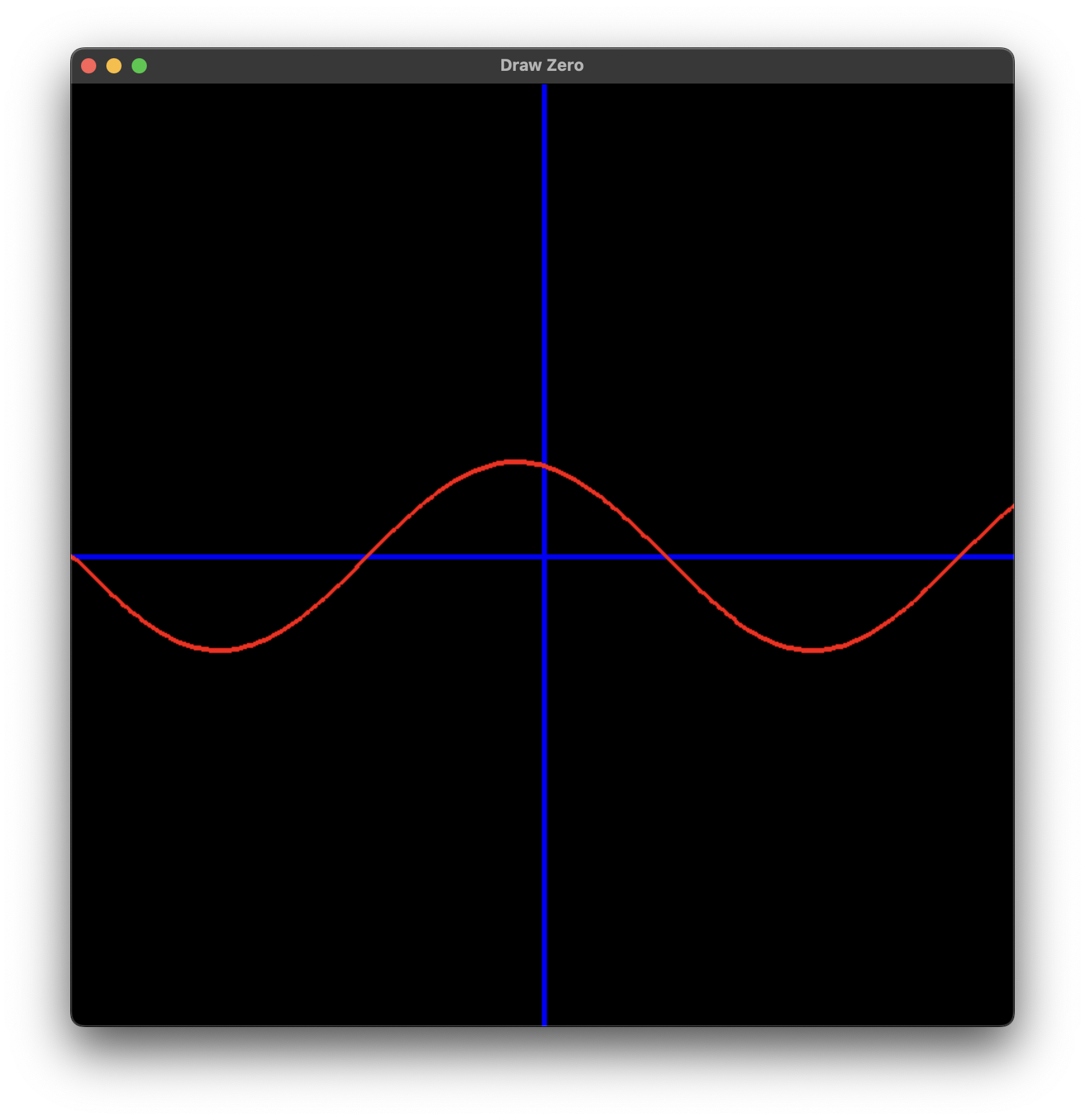
04_loops_sin_plot.py
from drawzero import *
from math import sin
line('blue', 0, 500, 1000, 500)
line('blue', 500, 0, 500, 1000)
STEP = 4
SCALE = 100
for x1 in range(0, 1000, STEP):
y1 = 500 + SCALE * sin(x1 / SCALE)
x2 = x1 + STEP
y2 = 500 + SCALE * sin(x2 / SCALE)
line('red', (x1, y1), (x2, y2))
Points and Turtle-style Graphics
The Pt class allows for vector math and turtle-like drawing commands.
05_points.py
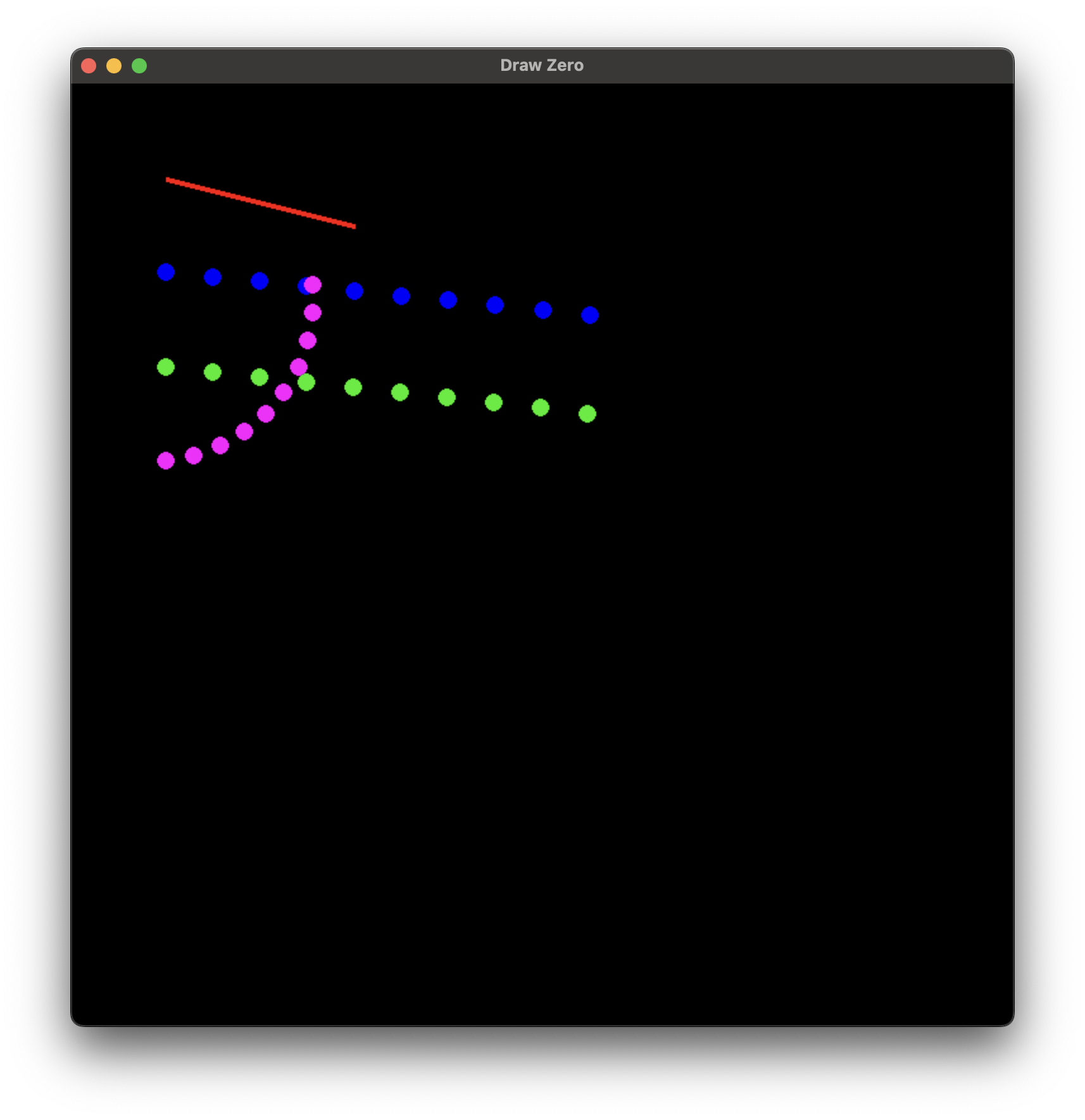
05_points.py
from drawzero import *
# just coordinates
A = Pt(100, 100)
B = Pt(300, 150)
line(C.red, A, B)
# A point which acts as 2-d vector and as a Turtle
# Pt(x=0.0, y=0.0, *, heading=0.0)
#
# Provides (for a, b — points, k number):
# * arithmetic
# a+b — vector addition
# a-b — vector subtraction
# k*a and a*k — multiplication with scalar
# abs — absolute value of a
# +a, -a
# arithmetic
A = Pt(100, 200)
dx = Pt(50, 5)
for i in range(10):
filled_circle(C.blue, A + dx * i, radius=10)
# * turtle-style movement
# forward — Move the point forward by the specified distance.
# backward — Move the point backward by distance.
# right — Turn point right by angle degrees.
# left — Turn point left by angle degrees.
# goto — Move point to an absolute position.
# rotate_around — Rotate around given point by angle degrees.
# move_towards — Move towards the given point by the specified distance.
# reset, home — Move point to the origin - coordinates (0,0), set heading=0
# setx — Set the point's first coordinate to x
# sety — Set the point's second coordinate to y
# setheading — Set the point's heading
A = Pt(100, 300)
B = Pt(1000, 400)
for i in range(10):
filled_circle(C.green2, A, radius=10)
A.move_towards(50, B)
A = Pt(100, 400)
for i in range(10):
filled_circle(C.magenta, A, radius=10)
A.left(10).forward(30)
# * information
# position — Return the point's current location (x,y), as a tuple.
# x, xcor — Return the point's x coordinate.
# y, ycor — Return the point's y coordinate
# heading — Return the point's heading
# distance — Return the distance between points
# towards — Return the angle towards point
# * deep copy
# copy — a clone of point
06_turtle_style.py
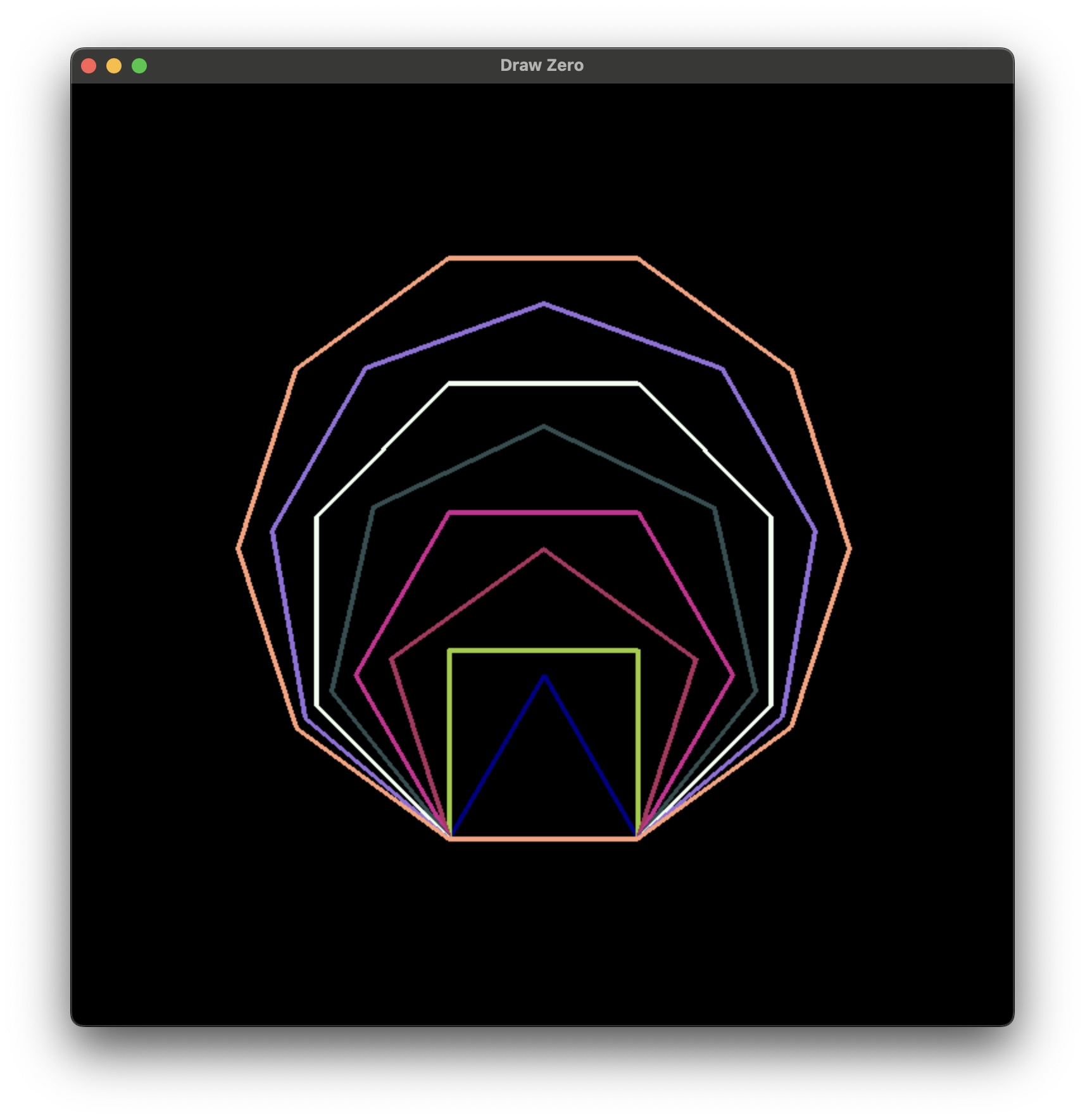
06_turtle_style.py
from drawzero import *
colors = [C.darkslategrey, C.dimgrey, C.slateblue, C.darkblue, C.yellowgreen, C.maroon,
C.violetred, C.darkslategray, C.honeydew, C.mediumpurple, C.lightsalmon]
# Drawing regular polygons for n from 3 to 10
# Рисуем правильные треугольник (n=3), четырёхугольник и т.д. до десятиугольник
for n in range(3, 11):
cur = Pt(600, 800)
# Drawing n lines for regular polygon
# Каждую сторону рисуем отдельно
for i in range(n):
prev = cur.copy()
# How to get next point? We clone the old one, rotate left and move forward a bit
# Чтобы получить новую вершину, мы клонируем старую, поворачиваемся и двигаемся вперёд
cur.left(360 / n)
cur.forward(200)
line(colors[n], prev, cur)
Animation
Bring your drawings to life with animations.
07_animation_circles.py
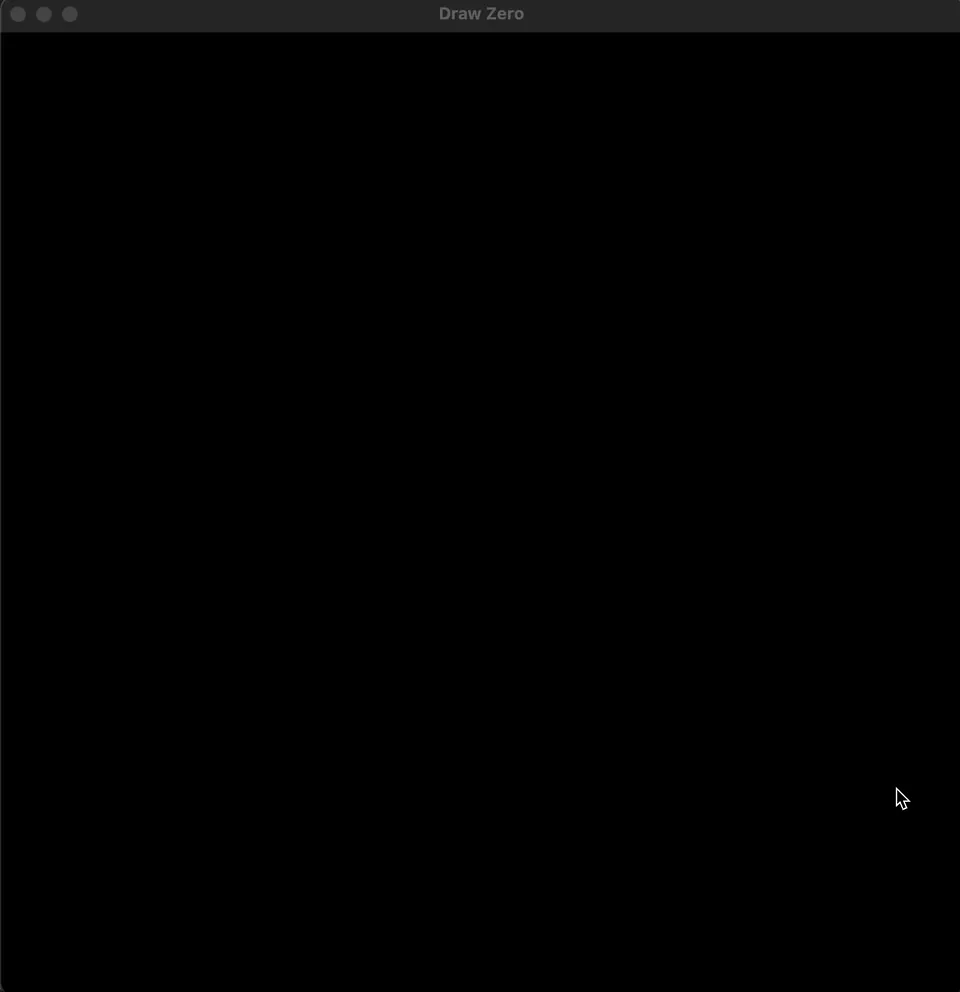
07_animation_circles.py
from drawzero import *
# Animations are straightforward
for i in range(0, 60 * 5, 3):
# Take color at "random"
# Выбираем цвет псевдослучайно
color = (i % 255, (19 * i) % 255, (91 * i) % 255)
x = 100 + 2 * i
y = 100 + i // 5
r = 20 + 4 * (i % 5)
circle(color, (x, y), r)
# Sleep for 1/30 second
# Самое главное для анимации — ждём 1/30 секунды
tick()
08_animation_traffic_light.py
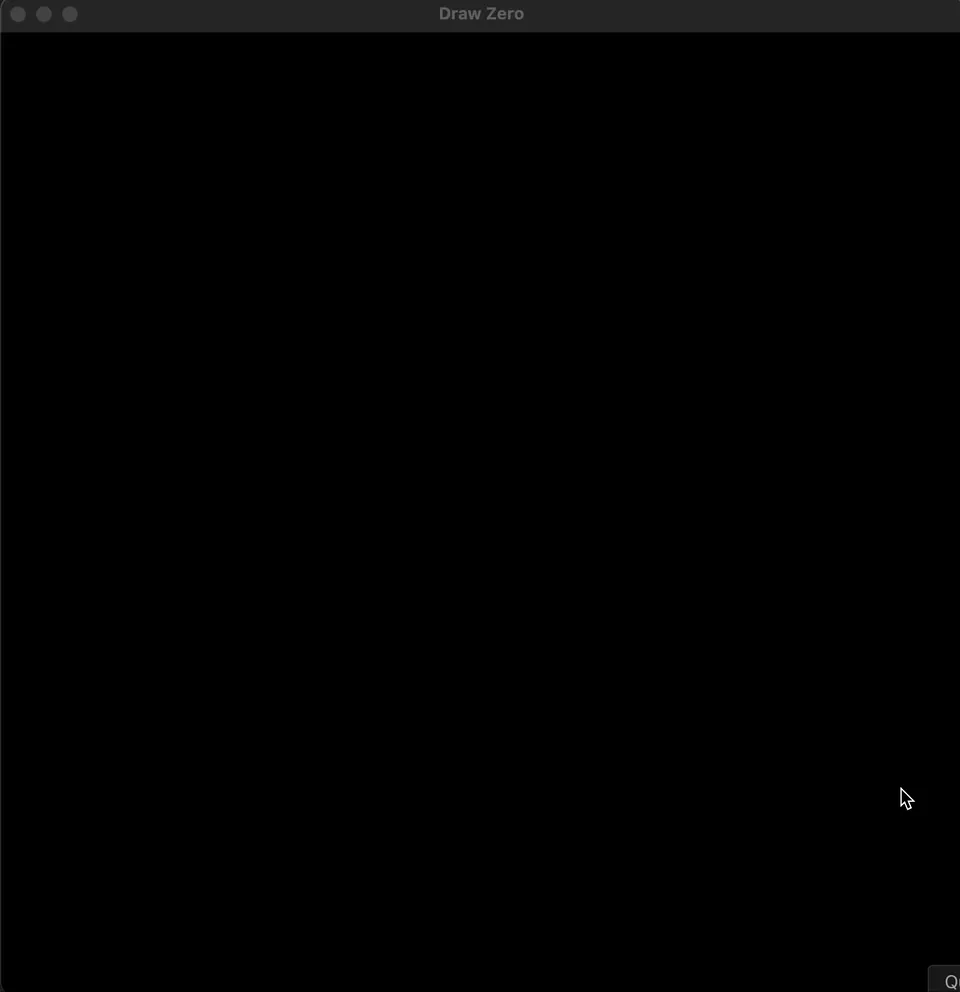
08_animation_traffic_light.py
from drawzero import *
# С — is an object with colors as attributes.
# С — специальный объект, у которого есть атрибуты — предопределённые цвета
# https://www.pygame.org/docs/ref/color_list.html
red_on = C.red
red_off = C.red4
yellow_on = C.yellow
yellow_off = C.yellow4
green_on = C.green
green_off = C.green4
fill(C.white)
def traf_light(red, yellow, green):
"""Function to draw signals with given colors
"""
filled_rect(C.black, (400, 300, 200, 480))
filled_circle(green, (500, 680), 60)
filled_circle(yellow, (500, 540), 60)
filled_circle(red, (500, 400), 60)
for i in range(3):
traf_light(red_on, yellow_off, green_off)
sleep(1)
traf_light(red_off, yellow_on, green_off)
sleep(1)
traf_light(red_off, yellow_off, green_on)
sleep(1)
traf_light(red_off, yellow_on, green_off)
sleep(1)
09_animation_rectangles.py
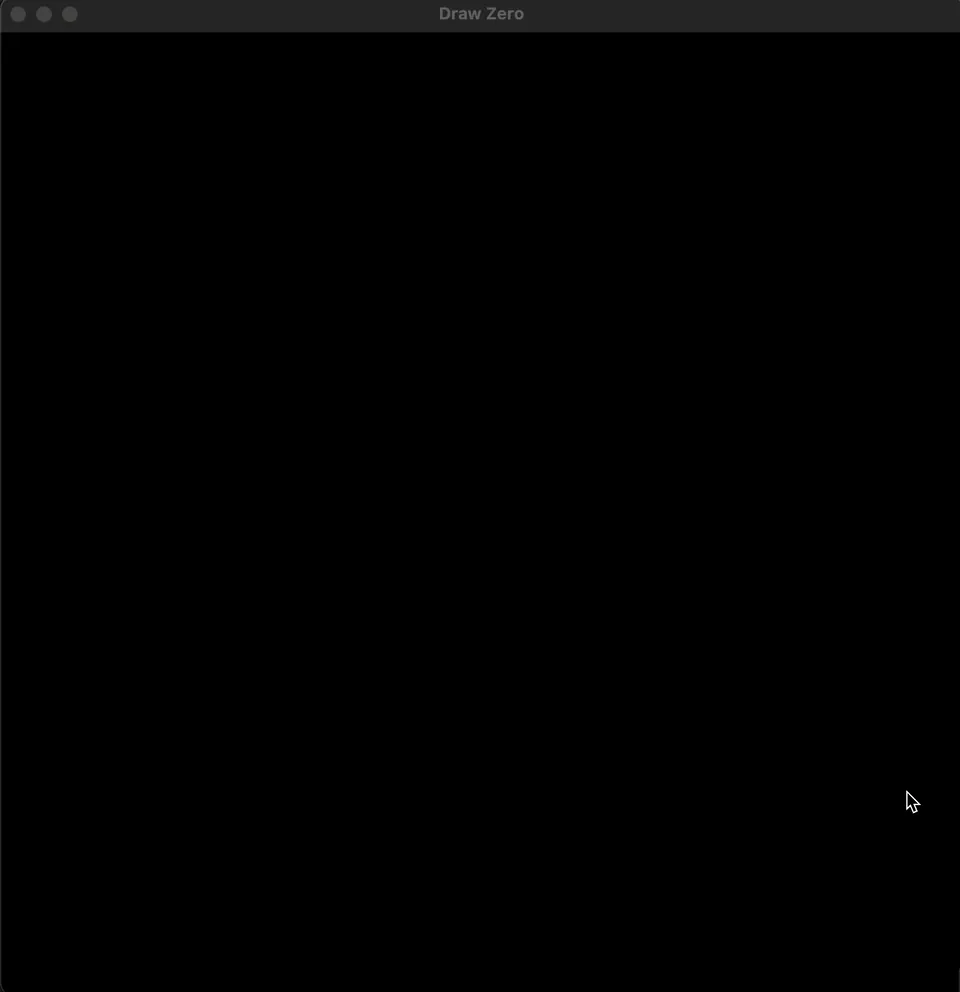
09_animation_rectangles.py
"""
In this example we use Pt class for turtle-like coordinate manipulations.
Используем класс Pt, позволяющий менять координаты в "черепашьем" стиле
"""
from drawzero import *
screen_center = Pt(500, 500)
small_rect_size = Pt(50, 30)
small_rect_center = screen_center + Pt(300, 0)
big_rect_size = Pt(100, 80)
big_rect_center = screen_center.copy()
for i in range(720):
# First we make all calculations for the next frame
# Rotate the big rectangle left by 3 degrees
big_rect_center.left(3)
# Line from the center outside the canvas using big rect heading
laser = big_rect_center.copy().forward(700)
# Rotate the small rect around the screen center for 1 degree
small_rect_center.rotate_around(1, screen_center)
# Rotate the small rect by 5 degrees
small_rect_center.right(5)
# Sleep 1/30 second
tick()
# No we clear the canvas and draw the next frame
clear()
# We need to subtract size/2 to get left upper rect position
filled_rect_rotated(C.green, big_rect_center - big_rect_size / 2, big_rect_size, angle=big_rect_center.heading)
# Sometimes we draw laser
if i % 37 <= 4:
line(C.orange, screen_center, laser, line_width=10, alpha=140)
# Transparent small rectangle orbit
circle(C.yellow, screen_center, 300, line_width=1, alpha=50)
filled_rect_rotated(C.red, small_rect_center - small_rect_size / 2, small_rect_size, angle=small_rect_center.heading)
circle(C.violet, screen_center, 10)
10_animation_planets.py
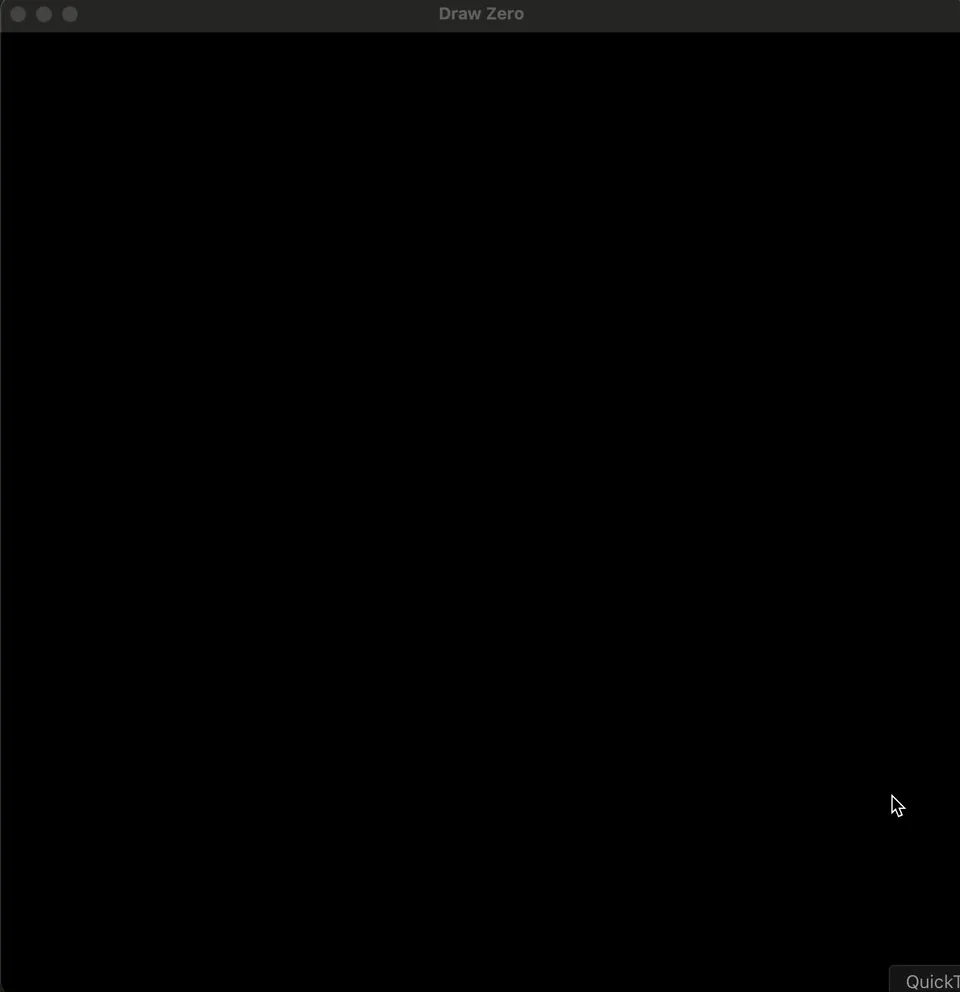
10_animation_planets.py
from drawzero import *
from math import sin, cos, pi
earth_orbit = 400
earth_radius = 30
earth_rot_step = 2 * pi / 360
moon_orbit = 100
moon_radius = 10
moon_rot_step = 2 * pi / 60
for i in range(360 * 2):
# First we make all calculations for the next frame
e_x = 500 + earth_orbit * cos(earth_rot_step * i)
e_y = 500 + earth_orbit * sin(earth_rot_step * i)
m_x = e_x + moon_orbit * cos(moon_rot_step * i)
m_y = e_y + moon_orbit * sin(moon_rot_step * i)
# Sleep 1/30 second
tick()
# No we clear the canvas and draw the next frame
clear()
filled_circle(C.red, (500, 500), 100)
filled_circle(C.blue, (e_x, e_y), earth_radius)
filled_circle(C.yellow, (m_x, m_y), moon_radius)
Advanced Drawing
Explore more advanced features like transparency, image rendering, and color gradients.
11_transparency_and_line_width.py
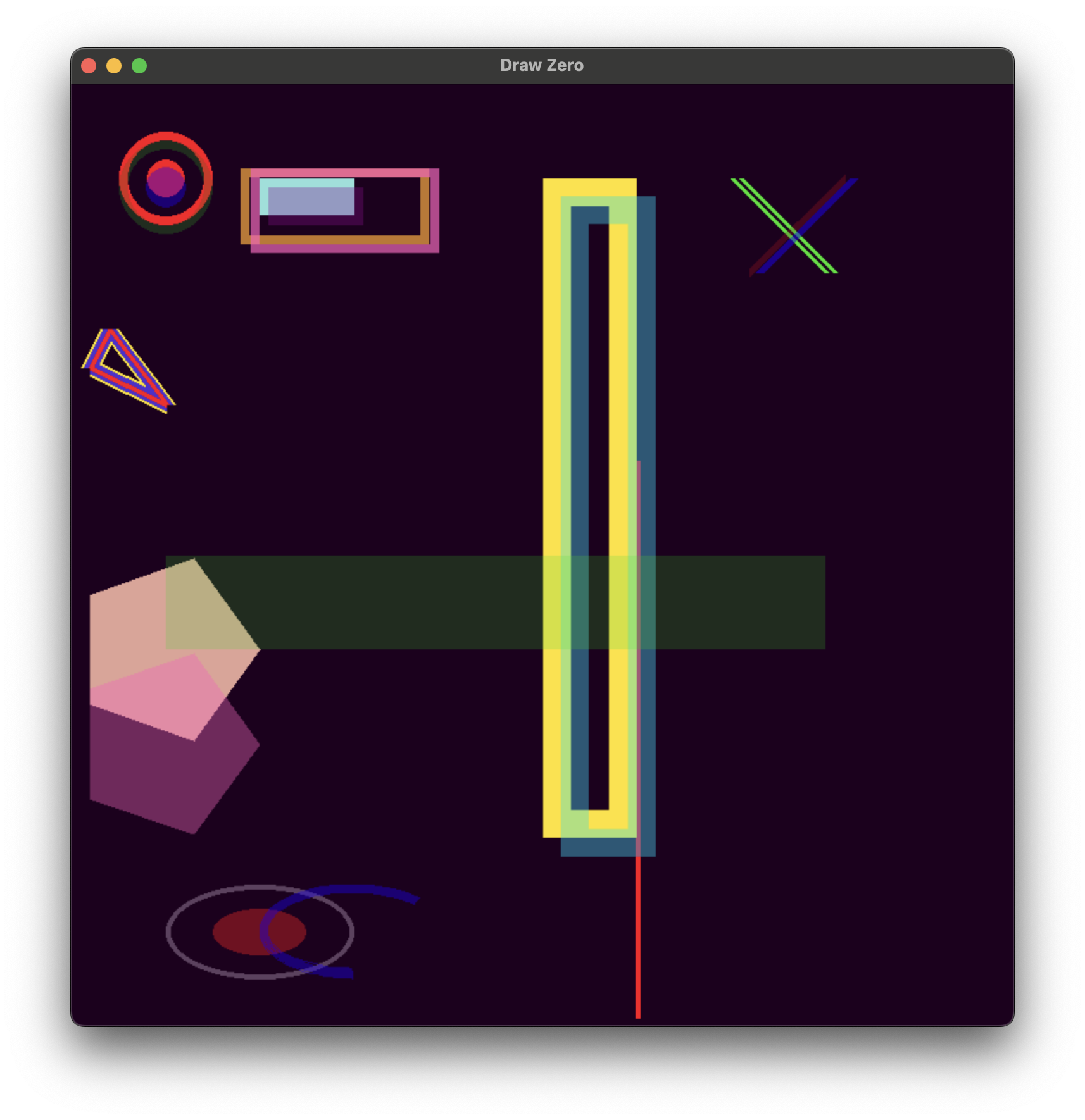
11_transparency_and_line_width.py
from drawzero import *
filled_circle('red', (100, 100), 20)
# Set line_width to change line_width
circle('red', (100, 100), 50, line_width=10)
# Set alpha from 0 to 255 to use transparency
filled_circle('blue', (100, 110), 22, alpha=100)
# Or user RGBA for color (RGBA stands for red green blue alpha)
circle((0, 255, 0, 50), (100, 110), 50, line_width=10)
filled_rect(C.aquamarine, (200, 100), 100, 40)
filled_rect(C.darkmagenta, (210, 110), 100, 40, alpha=80)
rect(C.darkgoldenrod, (180, 90), 200, 80, line_width=10)
rect(C.hotpink, (190, 90), 200, 90, alpha=180, line_width=10)
line('red', 600, 400, 600, 990)
polygon('yellow', [(20, 300), (100, 340), (40, 260)], line_width=20)
polygon((0, 0, 255, 200), [(20, 300), (100, 340), (40, 260)], line_width=15)
polygon('red', [(20, 300), (100, 340), (40, 260)])
filled_polygon('burlywood', 200, 600, 130, 504, 20, 542, 20, 658, 130, 696)
filled_polygon(C.hotpink, 200, 700, 130, 604, 20, 642, 20, 758, 130, 796, alpha=100)
line(C.green, (700, 100), (800, 200))
line(C.green, (710, 100), (810, 200), line_width=5)
line(C.red, (820, 100), (720, 200), line_width=10, alpha=50)
line(C.blue, (830, 100), (730, 200), line_width=10, alpha=128)
# Alpha channel is straightforward
rect('yellow', (500, 100), 100, 700, line_width=30, alpha=255) # via alpha
rect('#00FFFF', (520, 120), 100, 700, line_width=30, alpha=100) # via alpha
filled_rect((0, 255, 0, 50), (100, 500), 700, 100) # via rgba
ellipse('grey', (100, 850), 200, 100, alpha=100)
filled_ellipse('red', (100 + 50, 850 + 25), 100, 50, alpha=100)
arc('blue', (200, 850), 200, 100, start_angle=45, stop_angle=270, alpha=100, line_width=10)
fill(C.magenta, alpha=30)
12_images.py
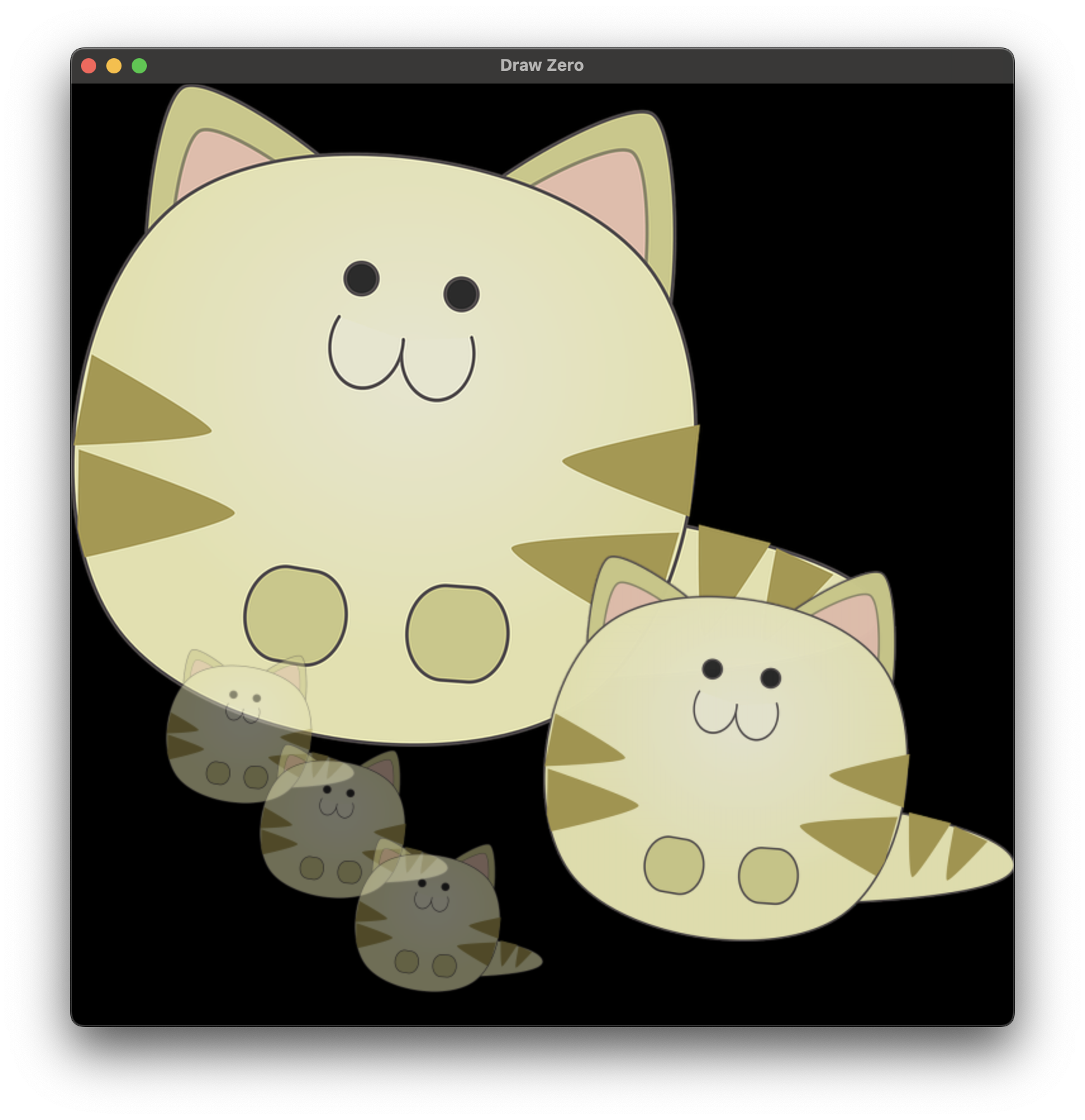
12_images.py
from pathlib import Path
from drawzero import *
this_file_dir = Path(__file__).parent.absolute()
image(this_file_dir / 'cat.png', (0, 0))
image(this_file_dir / 'cat.png', (500, 500), width=500)
image(this_file_dir / 'cat.png', (100, 600), width=200, alpha=128)
image(this_file_dir / 'cat.png', (200, 700), width=200, alpha=128)
image(this_file_dir / 'cat.png', (300, 800), width=200, alpha=128)
13_gradients.py
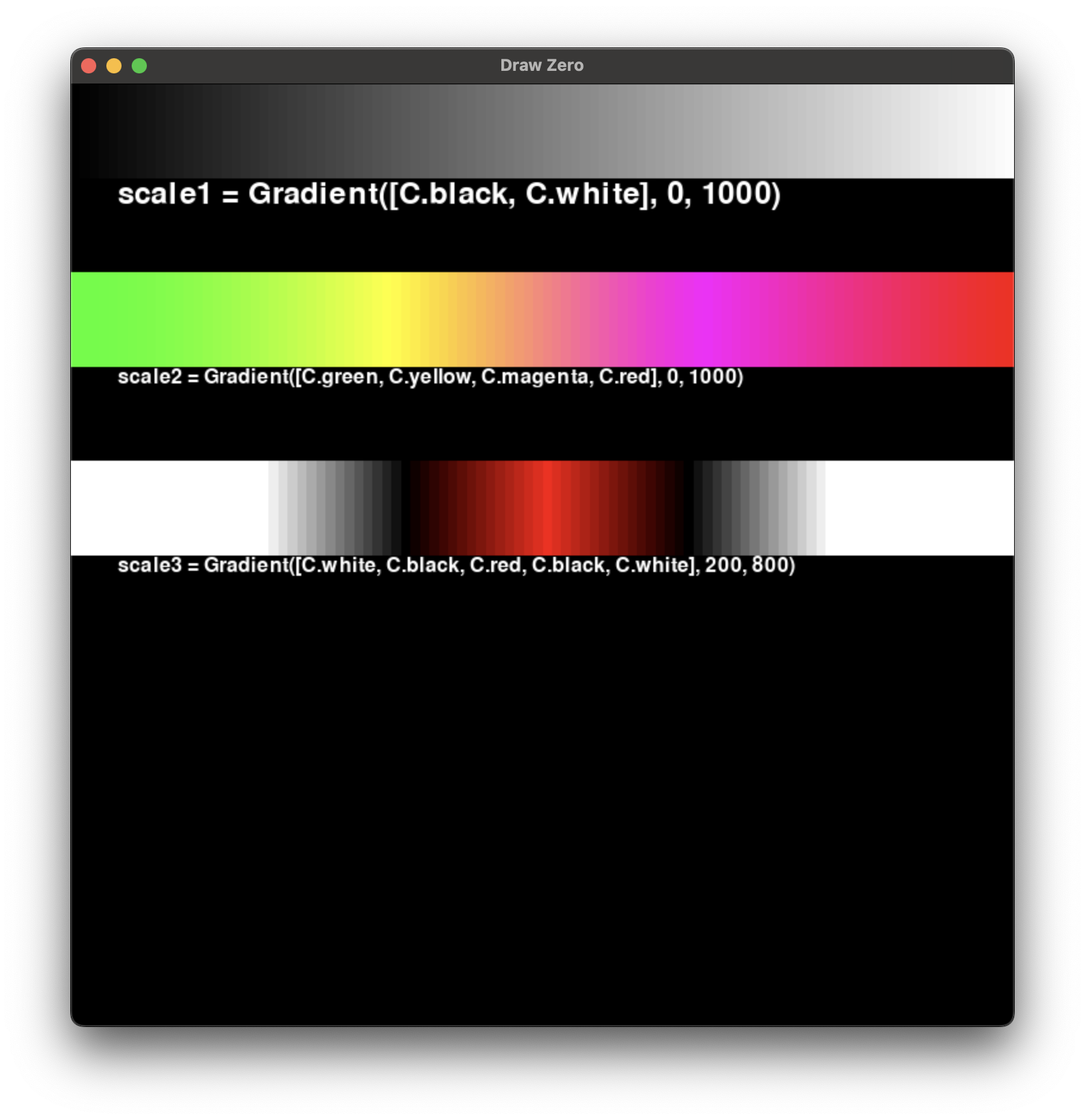
13_gradients.py
from drawzero import *
scale1 = Gradient([C.black, C.white], 0, 1000)
for x in range(0, 1000, 10):
filled_rect(scale1(x), (x, 0), 10, 100)
text(C.white, 'scale1 = Gradient([C.black, C.white], 0, 1000)', (50, 100), 48, '<^')
scale2 = Gradient([C.green, C.yellow, C.magenta, C.red], 0, 1000)
for x in range(0, 1000, 10):
filled_rect(scale2(x), (x, 200), 10, 100)
text(C.white, 'scale2 = Gradient([C.green, C.yellow, C.magenta, C.red], 0, 1000)', (50, 300), 32, '<^')
scale3 = Gradient([C.white, C.black, C.red, C.black, C.white], 200, 800)
for x in range(0, 1000, 10):
filled_rect(scale3(x), (x, 400), 10, 100)
text(C.white, 'scale3 = Gradient([C.white, C.black, C.red, C.black, C.white], 200, 800)', (50, 500), 32, '<^')
Interactive Examples
Make your creations interactive by responding to keyboard and mouse input.
14_animation_close_vertex.py
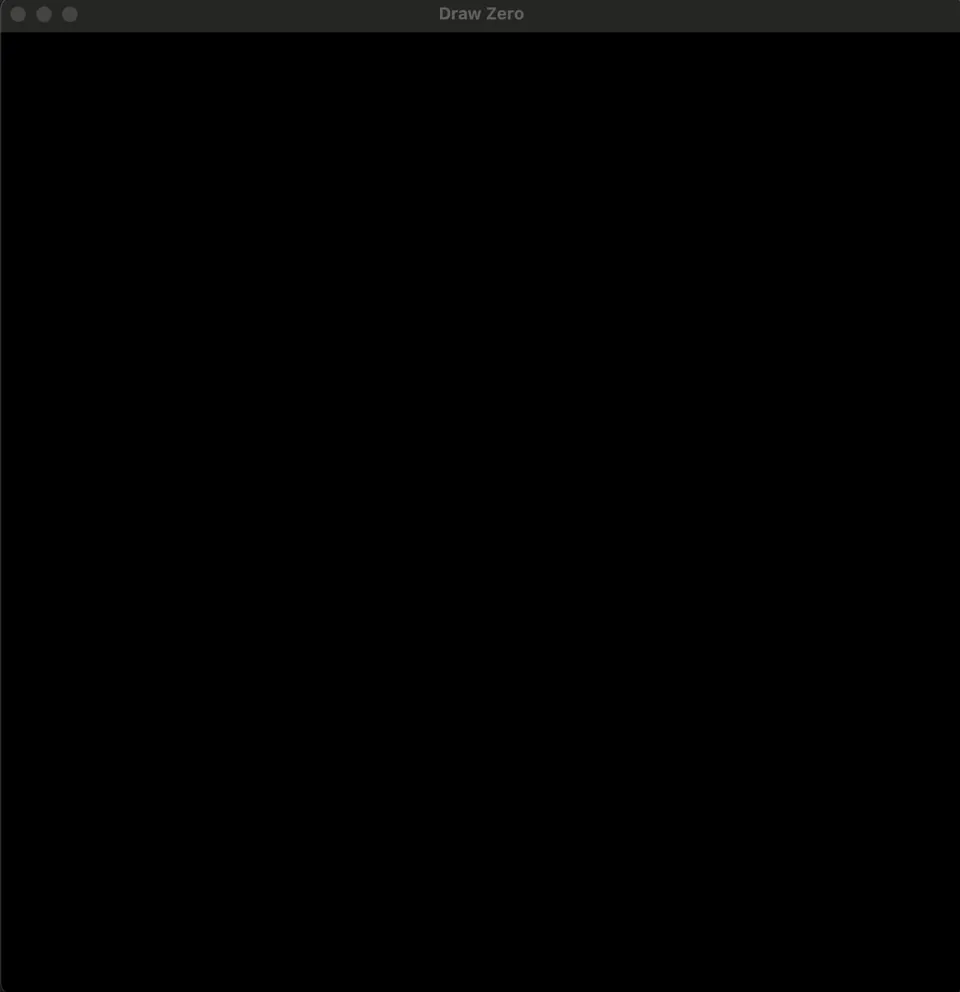
14_animation_close_vertex.py
from drawzero import *
from random import randint, uniform
from itertools import combinations
NUM_POINTS = 100
MIN_DIST = 150
MAX_SPEED = 4
"""
Here we use Pt class for coordinates. It looks like a tuple with .x and .y methods (and many other).
Здесь мы используем класс Pt для работы с координатами. Почти кортеж, только изменяемый с атрибутами .x и .y
"""
points = [
(Pt(randint(0, 1000), randint(0, 1000)), Pt(uniform(-MAX_SPEED, MAX_SPEED), uniform(-MAX_SPEED, MAX_SPEED)))
for __ in range(NUM_POINTS)
]
scale = Gradient(['#5cc3e6', C.black], 0, MIN_DIST)
for i in range(30 * 30):
# First we make all calculations for the next frame
for pt, v in points:
pt.x = (pt.x + v.x) % 1000
pt.y = (pt.y + v.y) % 1000
# Sleep 1/30 second
tick()
# No we clear the canvas and draw the next frame
clear()
for (pt1, v1), (pt2, v2) in combinations(points, r=2):
dist = pt1.distance(pt2)
if dist < MIN_DIST:
color = scale(dist)
line(color, pt1, pt2, line_width=1)
for pt, v in points:
filled_circle('blue', pt, 5)
fps()
15_animation_firework.py
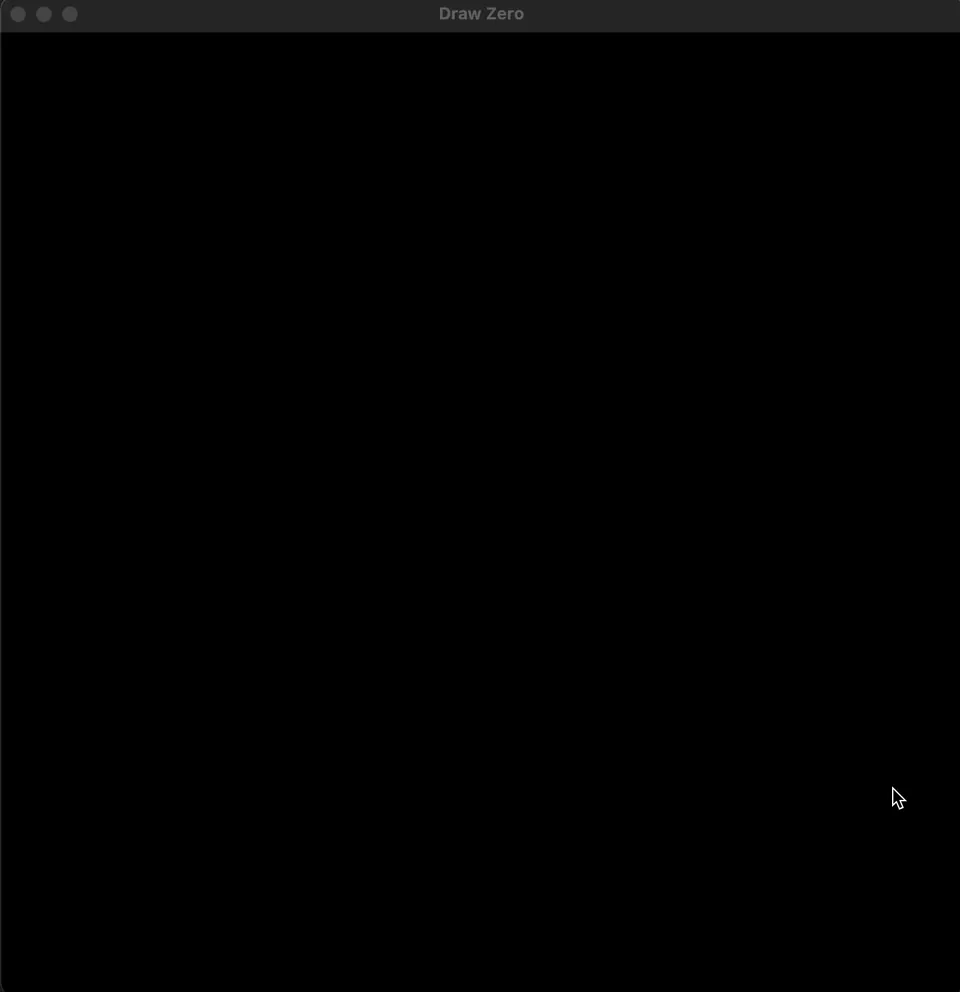
15_animation_firework.py
from drawzero import *
import random
import math
from typing import List
G = -2.0
class Particle:
vx: float
vy: float
cx: float
cy: float
color: tuple
alive: bool
max_age: int
age: int = 0
GLOW = 20
START_SPEED = 20
MAX_SIZE = 4
SCALE = Gradient([C.yellow, C.red], 0, GLOW)
def __init__(p, x, y):
random_angle = random.uniform(0, 2 * math.pi)
random_speed = random.uniform(p.START_SPEED * 0.5, p.START_SPEED * 1.5)
p.vx = math.cos(random_angle) * random_speed
p.vy = math.sin(random_angle) * random_speed
p.color = (random.randint(0, 255), random.randint(0, 255), random.randint(0, 255))
p.cx, p.cy = x, y
p.max_age = random.randint(5, p.GLOW)
p.alive = True
def draw(p):
if p.age < p.GLOW:
color = p.SCALE(p.age)
filled_circle(color, (p.cx, p.cy), p.MAX_SIZE * (p.GLOW - p.age) / p.GLOW)
def update(p):
p.cx += p.vx
p.cy += p.vy
p.vy -= G
p.age += 1
if p.cy > 1000 or p.age > p.max_age:
p.alive = False
class Firework:
STICK_WIDTH = 5
HANDLE = 200
NEW_PARTICLES = 25
HANDLE_COLOR = (64, 64, 64)
POWDER_COLOR = (255, 255, 255)
BURNT_COLOR = (102, 102, 102)
def __init__(self, x, y, height, sleep=2):
self.ticks = 0
self.x = x
self.y = y
self.height = height
self.particles: List[Particle] = []
self.cur_top = 0
self.sleep = sleep
def update(self):
self.ticks += 1
if self.ticks < 30 * self.sleep or self.cur_top > self.height:
return
self.cur_top += 1
self.update_particles()
self.remove_particles()
self.create_new_particles()
def draw(self):
self.draw_stick()
for p in self.particles:
p.draw()
def remove_particles(self):
last_good = -1
for cur in range(len(self.particles)):
p = self.particles[cur]
if p.alive:
last_good += 1
self.particles[last_good] = p
del self.particles[last_good + 1:]
def update_particles(self):
for p in self.particles:
p.update()
def create_new_particles(self):
if self.cur_top < self.height - self.HANDLE:
for __ in range(self.NEW_PARTICLES):
self.particles.append(Particle(x=self.x, y=self.y + self.cur_top))
def draw_stick(self):
w = self.STICK_WIDTH
real_top = min(self.cur_top, self.height - self.HANDLE)
filled_rect(self.HANDLE_COLOR, (self.x - w / 2, self.y), w, self.height)
filled_rect(self.BURNT_COLOR, (self.x - w / 2 - 2, self.y), w + 4, real_top)
filled_rect(self.POWDER_COLOR, (self.x - w / 2 - 3, self.y + real_top), w + 6, self.height - self.HANDLE - real_top)
def is_burnt(self):
return self.cur_top > 0 and len(self.particles) == 0
firework1 = Firework(x=333, y=200, height=600, sleep=1)
firework2 = Firework(x=666, y=400, height=500, sleep=2)
while not firework1.is_burnt() or not firework2.is_burnt():
firework1.update()
firework2.update()
tick()
clear()
firework1.draw()
firework2.draw()
fps()
sleep(1)
quit()
16_keyboard_and_mouse.py
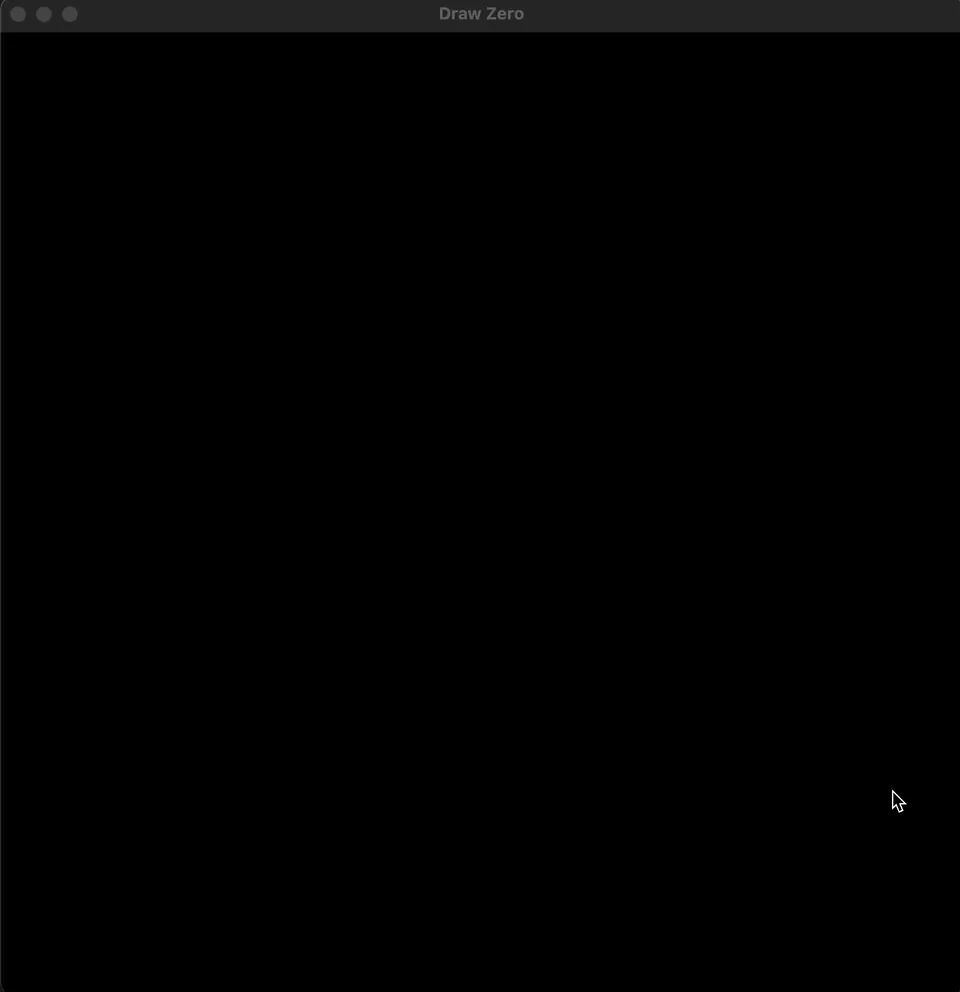
16_keyboard_and_mouse.py
from drawzero import *
typed_letters = 'Typed: '
SIZE = 20
x = y = 500 - SIZE // 2
while True:
# Mouse buttons events
if mousebuttonsdown:
x, y = mousebuttonsdown[0].pos
# Keys which are still pressed
keys = get_keys_pressed()
dx = dy = 0
if keys[K.LEFT] or keys[K.a]:
dx = -5
if keys[K.RIGHT] or keys[K.d]:
dx = +5
if keys[K.UP] or keys[K.w]:
dy = -5
if keys[K.DOWN] or keys[K.s]:
dy = +5
if keys[K.MOD_SHIFT] or keys[K.MOD_CTRL]:
dx *= 4
dy *= 4
x += dx
y += dy
# Keyboard events
for ev in keysdown:
if ev.unicode:
typed_letters += ev.unicode
# Redraw everything
clear()
text(C.white, 'Press arrows to move square', (500, 70), 48)
text(C.white, 'Press letters to type them', (500, 130), 48)
text(C.white, 'Click mouse to move square', (500, 190), 48)
text(C.green, typed_letters, (100, 250), 48, align='<.')
filled_rect(C.red, x, y, SIZE, SIZE)
filled_circle(C.yellow, mouse_pos(), 3)
tick()
17_mouse_tube.py
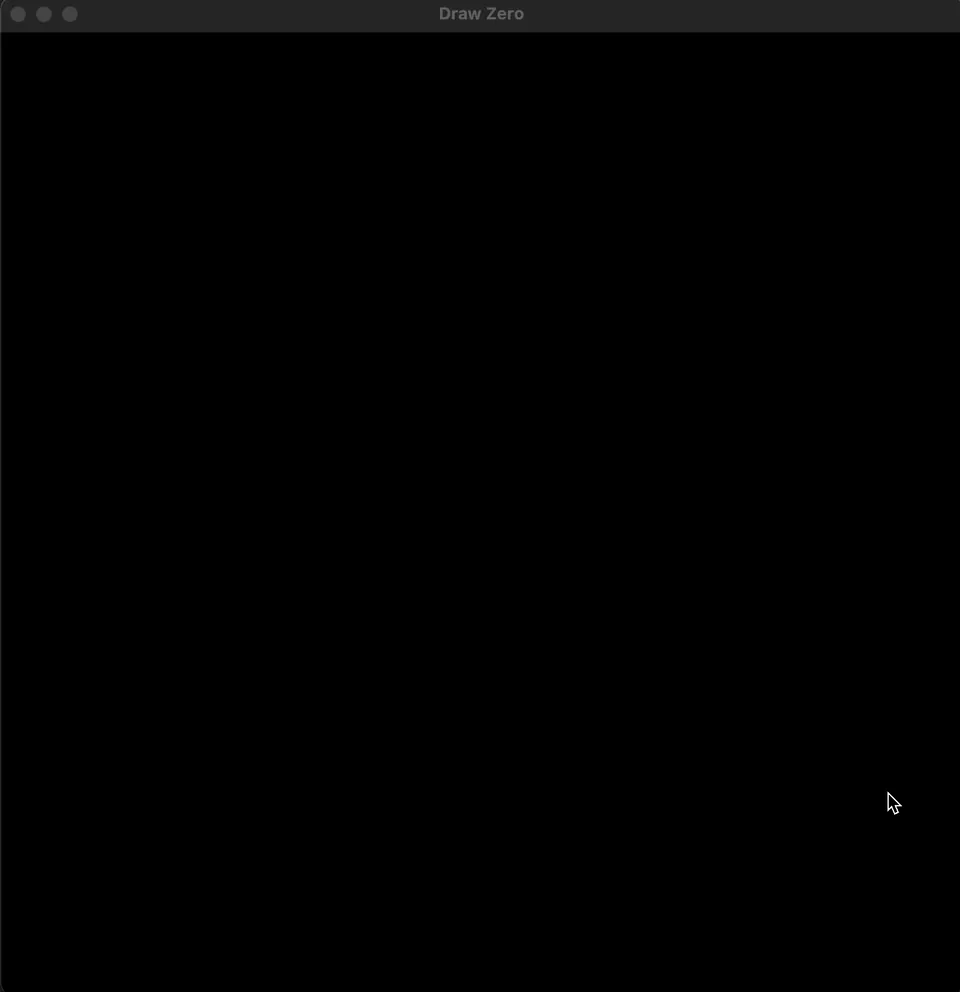
17_mouse_tube.py
from drawzero import *
circles = []
tick()
scale = Gradient([C.gray10, C.blue, C.orange], 100, 500)
while True:
x, y = mouse_pos()
circles.append([x, y, 100])
clear()
for i in range(len(circles) - 1, -1, -1):
x, y, r = circles[i]
if r > 1000:
circles.pop(i)
else:
circle(scale(r), (x, y), r, line_width=3)
circles[i][2] += 10
fps()
tick()
Games
Build simple games using the DrawZero library.
18_game_stars.py
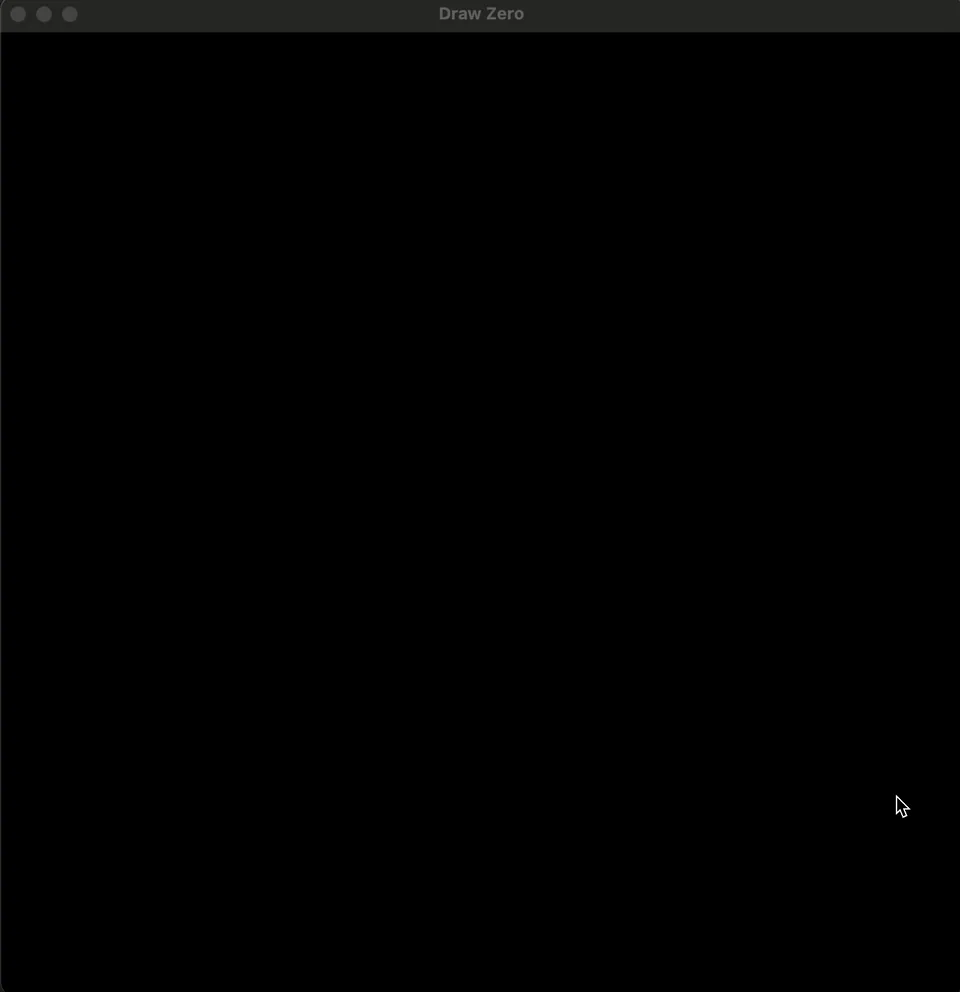
18_game_stars.py
from drawzero import *
from random import randint
from dataclasses import dataclass
from time import perf_counter
NUM_STARS = 300
@dataclass
class Star:
x: float
y: float
z: float
r: int
color: tuple
def gen_star():
'''Создать звезду'''
x = randint(-1000000 // 2, 1000000 // 2)
y = randint(1, 1000)
z = randint(-1000000 // 2, 1000000 // 2)
r = randint(10, 3000)
color = (randint(0, 255), randint(0, 255), randint(0, 255))
return Star(x, y, z, r, color)
def create_stars():
'''Создать массив звёзд'''
stars = []
for i in range(NUM_STARS):
stars.append(gen_star())
return stars
def move_stars(stars, speed):
'''Сдвинуть все звёзды
Если звезда перестала попадать на экран, то заменяем её на новую'''
Vx, Vy, Vz = speed
for i, star in enumerate(stars):
star.x += Vx
star.y += Vy
star.z += Vz
if (
not (1 < star.y < 1000)
or not (-500 < star.x / star.y < 500)
or not (-500 < star.x / star.y < 500)
):
# Вообще это — так себе решение. Но частично работает
stars[i] = gen_star()
def draw_stars(stars):
'''Отрисовать все звёзды'''
# Сортируем звёзды, чтобы те, которые ближе к экрану, отрисовывались позже
stars.sort(key=lambda star: -star.y)
for star in stars:
y = star.y
screen_x = 500 + star.x / y
screen_y = 500 + star.z / y
screen_r = star.r / y
filled_circle(star.color, (screen_x, screen_y), screen_r*2)
text('white', 'Press WASD or QE to move', (500, 5), 48, '.^')
def process_keys(pressed_keys, speed):
'''Обрабатываем нажатия клавиш
Используем WASD для вверх/вниз/влево/вправо и QE для вперёд/назад'''
if pressed_keys[K.UP] or pressed_keys[K.w]:
speed[2] += 100
if pressed_keys[K.DOWN] or pressed_keys[K.s]:
speed[2] -= 100
if pressed_keys[K.LEFT] or pressed_keys[K.a]:
speed[0] += 100
if pressed_keys[K.RIGHT] or pressed_keys[K.d]:
speed[0] -= 100
if pressed_keys[K.q]:
speed[1] -= 1
if pressed_keys[K.e]:
speed[1] += 1
# Здесь ставим размер экрана
stars = create_stars()
# Текущая скорость, стартуем с 0
speed = [0, 0, 0]
while True:
# Заливаем всё чёрным
fill((0, 0, 0))
# Обрабатываем нажатия клавиш
process_keys(get_keys_pressed(), speed)
# Двигаем звёзды
move_stars(stars, speed)
# Рисуем звёзды
draw_stars(stars)
# Ждём 1/60 секунды
tick()
19_game_colors.py
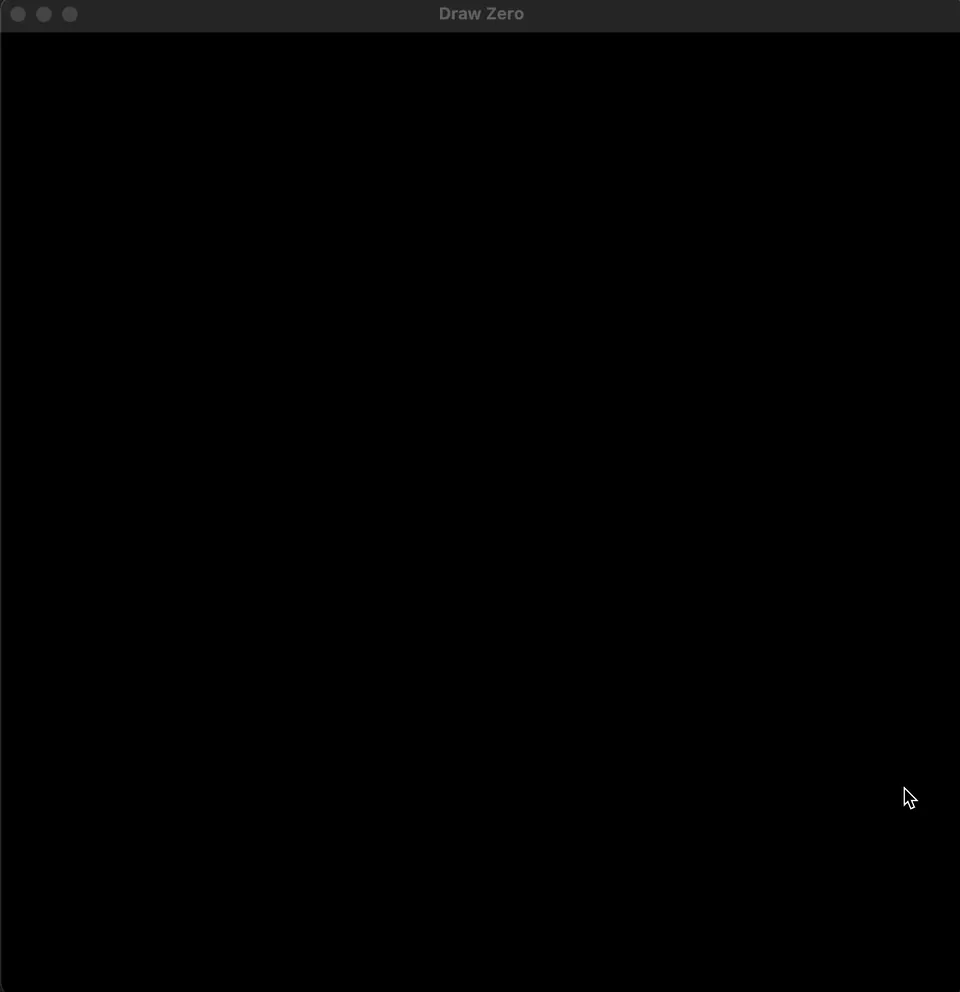
19_game_colors.py
from drawzero import *
import random
from time import time
COLORS = [('yellow', 'yellow'), ('green', 'green'), ('cyan', '#42aaff'), ('blue', '#0000ff'), ('purple', 'purple'),
('red', 'red'), ('orange', 'orange'), ('brown', 'brown'), ('gray', 'gray'), ('white', 'white'), ]
def gen_new():
cur_word, color = random.choice(COLORS)
corr = True
if random.random() < 0.5:
corr = False
new_color = color
while new_color == color:
__, color = random.choice(COLORS)
return cur_word, color, corr
score = 0
cur_timelimit = 4
cur_word, color, corr = gen_new()
cur_status = None
round_start = last_status_ts = time()
while True:
cur_ts = time()
time_left = round_start + cur_timelimit - cur_ts
if time_left < 0:
score -= 1
cur_timelimit *= 1.02
cur_word, color, corr = gen_new()
round_start = last_status_ts = cur_ts
cur_status = None
time_left = cur_timelimit
clear()
text('white', f'Scores: {score}', (500, 50), 48)
text('white', f'Double-click the left mouse button,', (500, 100), 32)
text('white', f'if the word and color match, otherwise right-click', (500, 142), 32)
text('white', f'{time_left:0.2f}s...', (500, 600), 48)
text(color, cur_word, (500, 500), 120)
if cur_status == 1:
text('green', 'Match?', (500, 700), 48)
elif cur_status == 3:
text('red', 'Mismatch?', (500, 800), 48)
# Ignore clicks for half a second after color change
for ev in mousebuttonsdown:
if cur_ts - last_status_ts > 0.3:
if ev.button == cur_status:
# User confirmed
if (corr and cur_status == 1) or (not corr and cur_status == 3):
score += 1
cur_timelimit *= 0.95
else:
score -= 1
cur_timelimit *= 1.02
cur_word, color, corr = gen_new()
round_start = last_status_ts = cur_ts
cur_status = None
elif ev.button in (1, 3):
cur_status = ev.button
last_status_ts = cur_ts
tick()
20_game_racing.py
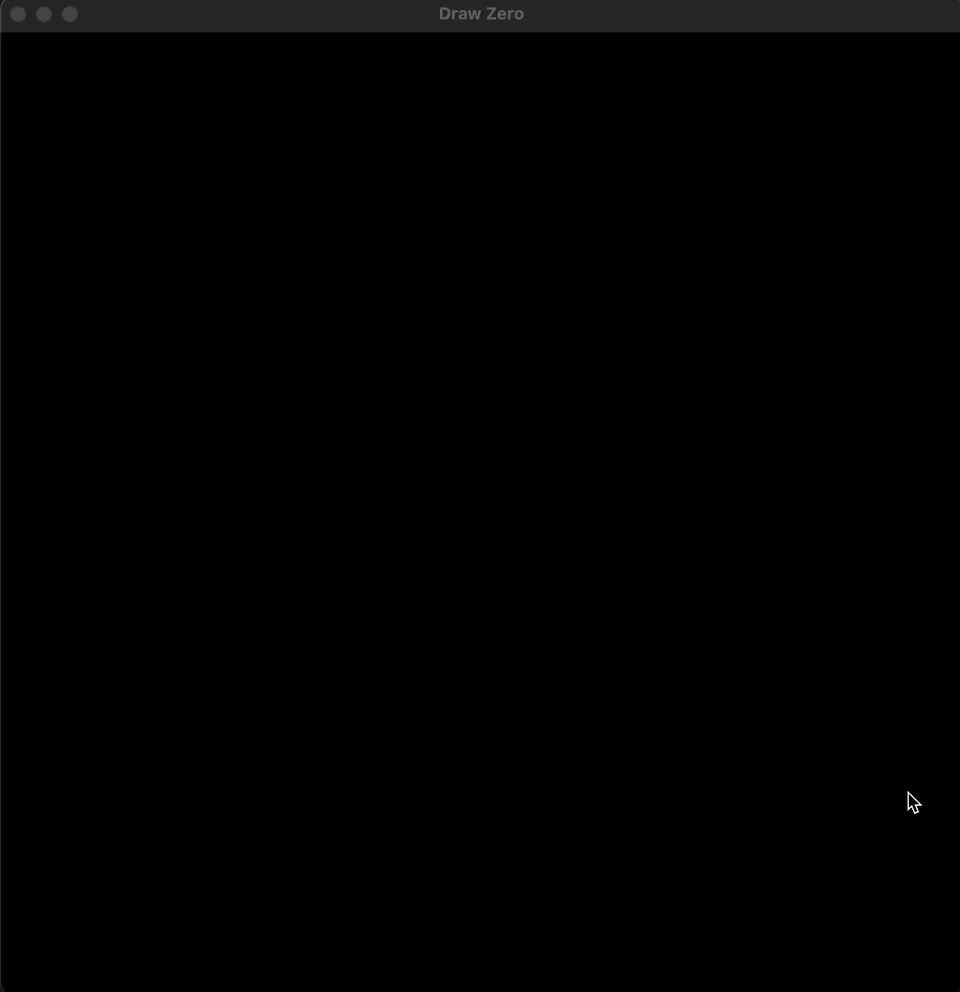
20_game_racing.py
from drawzero import *
cars_y = [540, 500, 460]
cars_x = [100, 100, 100]
ups = [K.w, K.i, K.UP]
downs = [K.s, K.k, K.DOWN]
lefts = [K.a, K.j, K.LEFT]
rights = [K.d, K.l, K.RIGHT]
colors = ['green', 'blue', 'yellow']
scores = [1000, 1000, 1000]
road = [500] * 30 + list(range(500, 700, 3)) + list(range(700, 900, 6)) + list(range(900, 100, -4)) + list(
range(100, 500, 8))
road.extend(road)
road.extend(road)
WIDTH2 = 80
road_pos = 0
for i in 3, 2, 1:
clear()
text('green', 'READY? ' + str(i), (300, 400), 128)
sleep(1)
while True:
keys = get_keys_pressed()
for i in range(len(cars_y)):
if keys[ups[i]]:
cars_y[i] -= 5
if keys[downs[i]]:
cars_y[i] += 5
if keys[lefts[i]]:
cars_x[i] -= 5
if keys[rights[i]]:
cars_x[i] += 5
clear()
for i in range(len(cars_y)):
filled_rect(colors[i], (cars_x[i], cars_y[i] - 20), 80, 40, alpha=70)
for i in range(100):
line('red', i * 10, road[i + road_pos] - WIDTH2, i * 10 + 10, road[i + 1 + road_pos] - WIDTH2)
line('red', i * 10, road[i + road_pos] + WIDTH2, i * 10 + 10, road[i + 1 + road_pos] + WIDTH2)
for i in range(len(cars_y)):
if cars_y[i] - 20 < road[cars_x[i] // 10 + road_pos] - WIDTH2:
text(colors[i], 'Boom!', (300 + 200 * i, 10), 72)
cars_y[i] = road[cars_x[i] // 10 + road_pos] - WIDTH2 + 20
scores[i] -= 1
elif cars_y[i] + 20 > road[cars_x[i] // 10 + road_pos] + WIDTH2:
text(colors[i], 'Boom!', (300 + 200 * i, 10), 72)
cars_y[i] = road[cars_x[i] // 10 + road_pos] + WIDTH2 - 20
scores[i] -= 1
text(colors[i], str(scores[i]), (300 + 200 * i, 100), 72)
tick()
road_pos += 1
if road_pos > 1000:
i = scores.index(max(scores))
text('white', f'{colors[i]} is winner!', (150, 900), 128)
tick()
break